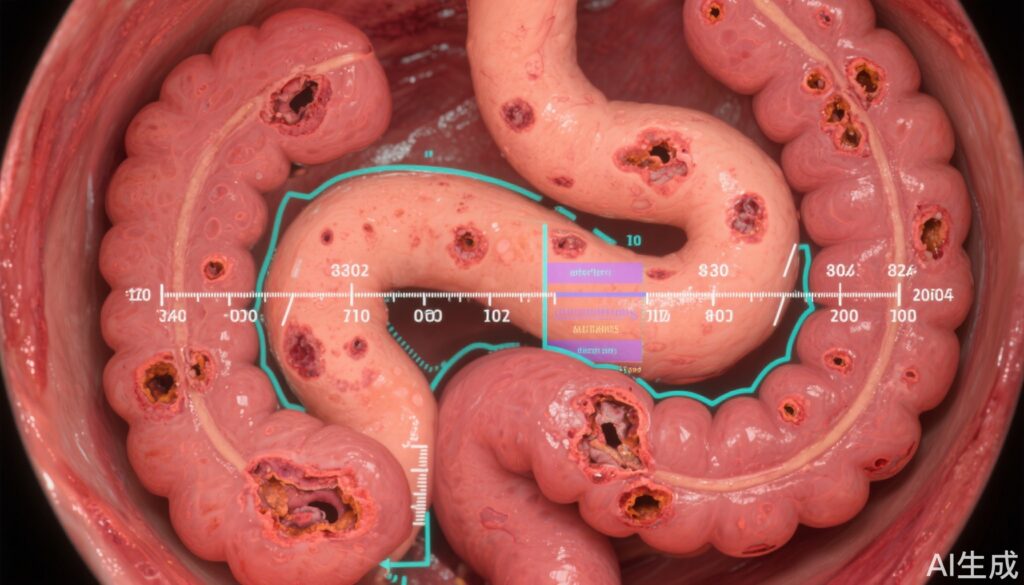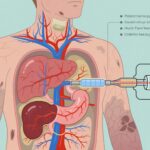Highlights
- EASE-CD is a newly developed and externally validated index for quantifying endoscopic ulcer activity in Crohn’s disease.
- Demonstrates substantial inter-rater reliability (ICC=0.798) and strong responsiveness to treatment (WinP=0.769).
- Improves upon older indices by offering clearer definitions, better reliability, and validated thresholds for clinically meaningful change.
- Provides a continuous score (0–100) with ulcer-free remission defined as zero.
Clinical Background and Disease Burden
Crohn’s disease is a chronic, relapsing inflammatory bowel disease (IBD) characterized by patchy, transmural inflammation affecting any part of the gastrointestinal tract. Endoscopic assessment is central to disease management, as mucosal healing predicts long-term remission and reduced complications. However, existing endoscopic indices, such as the Simple Endoscopic Score for Crohn’s Disease (SES-CD) and Crohn’s Disease Endoscopic Index of Severity (CDEIS), are hampered by modest correlation with clinical disease activity, ambiguous item definitions, poor interobserver reliability, and lack of validated response thresholds. This has undermined their utility in both clinical trials and routine care, creating an unmet need for a robust, reliable, and interpretable scoring system.
Methodology
To address these limitations, Ma and colleagues conducted a multiphase study to develop and validate the Endoscopic ulcer Activity Score for Evaluation of Crohn’s Disease (EASE-CD). The development process involved rigorous methodological steps:
- Paired baseline and post-induction ileocolonoscopy videos were collected from two randomized controlled trials: a phase 3b adalimumab trial (NCT00348283, n=112) and a phase 2 risankizumab trial (NCT02031276, n=99).
- Four central readers, blinded to clinical data and treatment assignment, evaluated the videos using candidate endoscopic items derived through modified RAND/UCLA appropriateness methods. This ensured face validity and minimized bias.
- Inter-rater reliability was assessed using the intraclass correlation coefficient (ICC), with a threshold of ≥0.41 for item inclusion.
- Responsiveness was measured by win probability (WinP), which estimates the likelihood that a treated patient has a better endoscopic score than a placebo patient (threshold ≥0.56).
- Items meeting these criteria were entered into regression modeling with internal validation via bootstrapping. External validation was performed using the risankizumab trial data.
Key Findings
Ten endoscopic items met the reliability and responsiveness criteria. These items drew from established indices (SES-CD, CDEIS) and included exploratory lesion characteristics specific to Crohn’s disease. The final EASE-CD model comprised:
- Presence and size of ulcerations (ordinal scale: none, 20 mm)
- Presence/absence of deep ulcerations (dichotomous)
- Proportion of ulcerated surface area (continuous, 0–1, averaged across segments)
The EASE-CD yields a continuous score from 0–100, with higher scores reflecting greater ulcer activity. Notable performance metrics include:
- Internal validation: r²=0.608 (optimism-adjusted r²=0.554), calibration slope 0.983
- External validation: adjusted r²=0.565, calibration slope 0.997
- Inter-rater reliability: ICC 0.798 (95% CI 0.711–0.836)
- Responsiveness: WinP 0.769 (95% CI 0.658–0.851, p<0.001)
- A 10-point reduction in EASE-CD indicates endoscopic response (≥50% reduction in SES-CD/CDEIS) with 82.4% specificity and 69.9% sensitivity
- Ulcer-free endoscopic remission yields an EASE-CD score of 0
These results underscore the index’s robust discriminatory capacity for treatment effects and its suitability for both clinical trial endpoints and potential clinical practice adoption.
Expert Commentary
The development of EASE-CD addresses longstanding issues with previous indices, especially interobserver variability and lack of standardization in item definitions. Leading gastroenterologists have highlighted the need for indices with validated thresholds to enable reliable assessment of mucosal healing and treatment response, both in trials and real-world settings. EASE-CD’s performance metrics suggest it may fulfill this need, although its integration into clinical workflows and regulatory frameworks will require further dissemination and education.
Controversies and Limitations
While EASE-CD demonstrates strong validation, several questions remain:
- The index primarily measures ulceration and may not fully capture other features of Crohn’s disease activity (e.g., stricturing, non-ulcerative inflammation).
- Both derivation and validation datasets stem from clinical trial populations, which may not fully represent the diversity seen in broader clinical practice.
- Further independent validation in real-world cohorts, pediatric populations, and less experienced reader settings is warranted.
- Assessment requires standardized, high-quality endoscopic imaging and trained central readers, which may limit immediate implementation in all practice settings.
Conclusion
The EASE-CD is an evidence-based, rigorously validated endoscopic scoring system for Crohn’s disease ulcer activity. It outperforms older indices in reliability, responsiveness, and interpretability. Adoption of EASE-CD in clinical trials and, potentially, in practice could standardize the assessment of mucosal healing and facilitate more meaningful comparisons of therapeutic efficacy. Continued validation and implementation research will be crucial to maximizing its clinical impact.
References
Ma C, Khanna R, Maguire BR, Zou G, Bressler B, Hindryckx P, Mosli M, Sparrow MP, Hart AL, Leong RW, Rubin DT, Rémillard J, Shackelton LM, D’Haens GR, Danese S, Peyrin-Biroulet L, Sands BE, Panaccione R, Feagan BG, Jairath V. Development and validation of a novel Endoscopic ulcer Activity Score for Evaluation of Crohn’s Disease (EASE-CD) using data from two randomised controlled trials. Lancet Gastroenterol Hepatol. 2025 Aug;10(8):746-756. doi: 10.1016/S2468-1253(25)00093-7 IF: 38.6 Q1 . Epub 2025 Jun 9. PMID: 40505666 IF: 38.6 Q1 .
Additional references:
Daperno M, et al. Development and validation of a new, simplified endoscopic activity score for Crohn’s disease: the SES-CD. Gastrointest Endosc. 2004;60(4):505-512.
Mary JY, Modigliani R. Development and validation of an endoscopic index of the severity for Crohn’s disease: the CDEIS. Gastroenterology. 1989;96(6):1327-1334.


